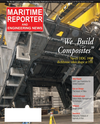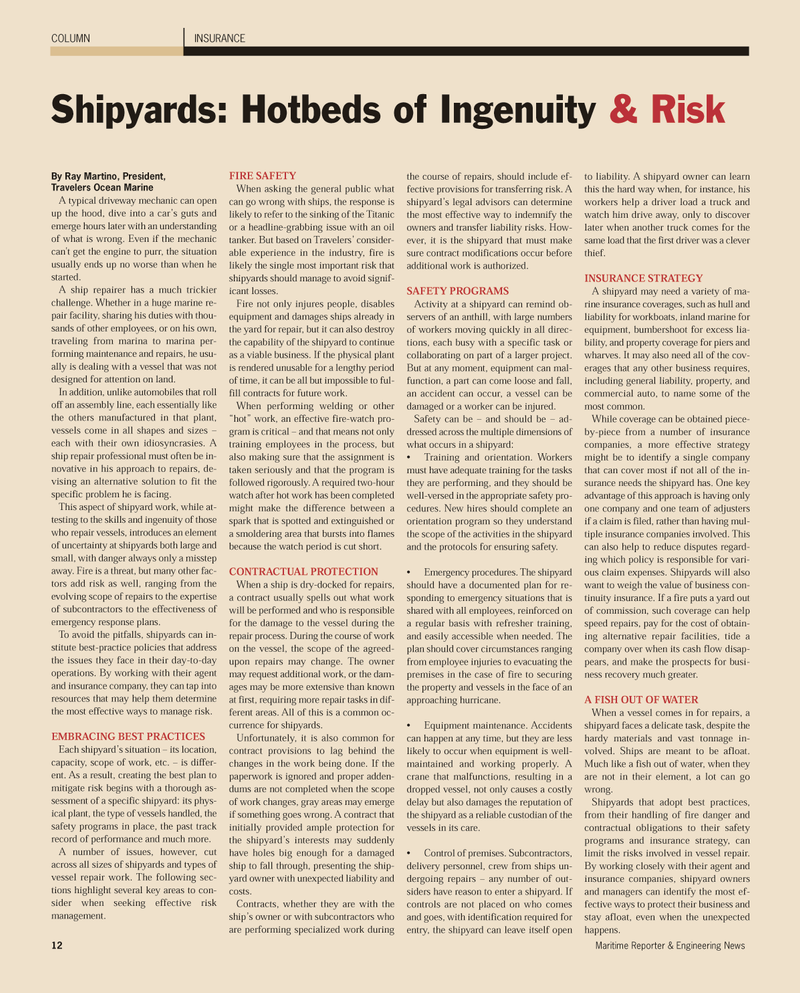
Page 12: of Maritime Reporter Magazine (January 2012)
US Navy Report
Read this page in Pdf, Flash or Html5 edition of January 2012 Maritime Reporter Magazine
By Ray Martino, President, Travelers Ocean Marine A typical driveway mechanic can open up the hood, dive into a car?s guts and emerge hours later with an understanding of what is wrong. Even if the mechanic can't get the engine to purr, the situation usually ends up no worse than when he started.A ship repairer has a much trickierchallenge. Whether in a huge marine re- pair facility, sharing his duties with thou- sands of other employees, or on his own, traveling from marina to marina per- forming maintenance and repairs, he usu-ally is dealing with a vessel that was not designed for attention on land.In addition, unlike automobiles that roll off an assembly line, each essentially like the others manufactured in that plant, vessels come in all shapes and sizes ? each with their own idiosyncrasies. A ship repair professional must often be in-novative in his approach to repairs, de- vising an alternative solution to fit the specific problem he is facing. This aspect of shipyard work, while at- testing to the skills and ingenuity of thosewho repair vessels, introduces an element of uncertainty at shipyards both large and small, with danger always only a misstep away. Fire is a threat, but many other fac- tors add risk as well, ranging from theevolving scope of repairs to the expertise of subcontractors to the effectiveness of emergency response plans. To avoid the pitfalls, shipyards can in- stitute best-practice policies that addressthe issues they face in their day-to-day operations. By working with their agent and insurance company, they can tap into resources that may help them determinethe most effective ways to manage risk. EMBRACING BEST PRACTICES Each shipyard?s situation ? its location, capacity, scope of work, etc. ? is differ- ent. As a result, creating the best plan to mitigate risk begins with a thorough as- sessment of a specific shipyard: its phys- ical plant, the type of vessels handled, the safety programs in place, the past trackrecord of performance and much more.A number of issues, however, cut across all sizes of shipyards and types of vessel repair work. The following sec- tions highlight several key areas to con- sider when seeking effective risk management.FIRE SAFETYWhen asking the general public whatcan go wrong with ships, the response islikely to refer to the sinking of the Titanic or a headline-grabbing issue with an oiltanker. But based on Travelers? consider- able experience in the industry, fire is likely the single most important risk that shipyards should manage to avoid signif- icant losses. Fire not only injures people, disablesequipment and damages ships already inthe yard for repair, but it can also destroy the capability of the shipyard to continue as a viable business. If the physical plant is rendered unusable for a lengthy period of time, it can be all but impossible to ful- fill contracts for future work. When performing welding or other?hot? work, an effective fire-watch pro- gram is critical ? and that means not onlytraining employees in the process, but also making sure that the assignment istaken seriously and that the program is followed rigorously. A required two-hour watch after hot work has been completed might make the difference between a spark that is spotted and extinguished or a smoldering area that bursts into flames because the watch period is cut short. CONTRACTUAL PROTECTION When a ship is dry-docked for repairs, a contract usually spells out what workwill be performed and who is responsiblefor the damage to the vessel during the repair process. During the course of work on the vessel, the scope of the agreed- upon repairs may change. The owner may request additional work, or the dam- ages may be more extensive than known at first, requiring more repair tasks in dif- ferent areas. All of this is a common oc- currence for shipyards. Unfortunately, it is also common for contract provisions to lag behind the changes in the work being done. If the paperwork is ignored and proper adden- dums are not completed when the scopeof work changes, gray areas may emerge if something goes wrong. A contract that initially provided ample protection for the shipyard?s interests may suddenly have holes big enough for a damaged ship to fall through, presenting the ship- yard owner with unexpected liability and costs.Contracts, whether they are with the ship?s owner or with subcontractors who are performing specialized work during the course of repairs, should include ef-fective provisions for transferring risk. A shipyard?s legal advisors can determine the most effective way to indemnify the owners and transfer liability risks. How- ever, it is the shipyard that must make sure contract modifications occur before additional work is authorized. SAFETY PROGRAMS Activity at a shipyard can remind ob- servers of an anthill, with large numbers of workers moving quickly in all direc- tions, each busy with a specific task or collaborating on part of a larger project. But at any moment, equipment can mal- function, a part can come loose and fall, an accident can occur, a vessel can be damaged or a worker can be injured. Safety can be ? and should be ? ad-dressed across the multiple dimensions ofwhat occurs in a shipyard: Training and orientation. Workers must have adequate training for the tasks they are performing, and they should be well-versed in the appropriate safety pro- cedures. New hires should complete an orientation program so they understand the scope of the activities in the shipyard and the protocols for ensuring safety. Emergency procedures. The shipyard should have a documented plan for re- sponding to emergency situations that is shared with all employees, reinforced on a regular basis with refresher training, and easily accessible when needed. The plan should cover circumstances ranging from employee injuries to evacuating the premises in the case of fire to securing the property and vessels in the face of an approaching hurricane.Equipment maintenance. Accidents can happen at any time, but they are less likely to occur when equipment is well- maintained and working properly. A crane that malfunctions, resulting in adropped vessel, not only causes a costly delay but also damages the reputation of the shipyard as a reliable custodian of the vessels in its care. Control of premises. Subcontractors, delivery personnel, crew from ships un- dergoing repairs ? any number of out- siders have reason to enter a shipyard. If controls are not placed on who comesand goes, with identification required for entry, the shipyard can leave itself open to liability. A shipyard owner can learn this the hard way when, for instance, his workers help a driver load a truck and watch him drive away, only to discover later when another truck comes for thesame load that the first driver was a clever thief.INSURANCE STRATEGY A shipyard may need a variety of ma- rine insurance coverages, such as hull and liability for workboats, inland marine for equipment, bumbershoot for excess lia- bility, and property coverage for piers and wharves. It may also need all of the cov- erages that any other business requires, including general liability, property, and commercial auto, to name some of themost common.While coverage can be obtained piece- by-piece from a number of insurancecompanies, a more effective strategy might be to identify a single company that can cover most if not all of the in- surance needs the shipyard has. One key advantage of this approach is having only one company and one team of adjusters if a claim is filed, rather than having mul- tiple insurance companies involved. This can also help to reduce disputes regard- ing which policy is responsible for vari- ous claim expenses. Shipyards will also want to weigh the value of business con- tinuity insurance. If a fire puts a yard out of commission, such coverage can help speed repairs, pay for the cost of obtain-ing alternative repair facilities, tide a company over when its cash flow disap- pears, and make the prospects for busi- ness recovery much greater. A FISH OUT OF WATER When a vessel comes in for repairs, a shipyard faces a delicate task, despite the hardy materials and vast tonnage in- volved. Ships are meant to be afloat. Much like a fish out of water, when they are not in their element, a lot can gowrong. Shipyards that adopt best practices, from their handling of fire danger and contractual obligations to their safety programs and insurance strategy, can limit the risks involved in vessel repair. By working closely with their agent and insurance companies, shipyard owners and managers can identify the most ef-fective ways to protect their business and stay afloat, even when the unexpected happens.12Maritime Reporter & Engineering News INSURANCECOLUMNShipyards: Hotbeds of Ingenuity & RiskMR Jan.12 # 2 (10-17):MR Template 1/9/2012 11:42 AM Page 12

 11
11

 13
13
